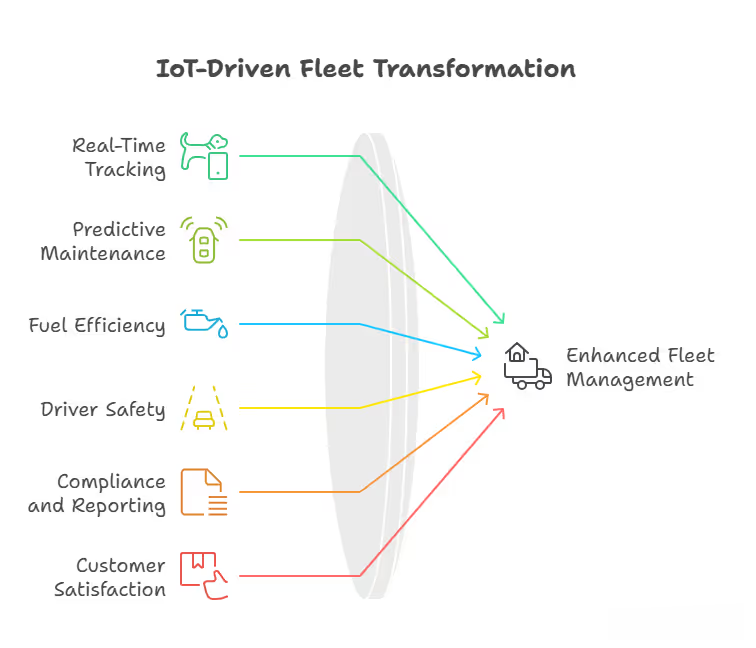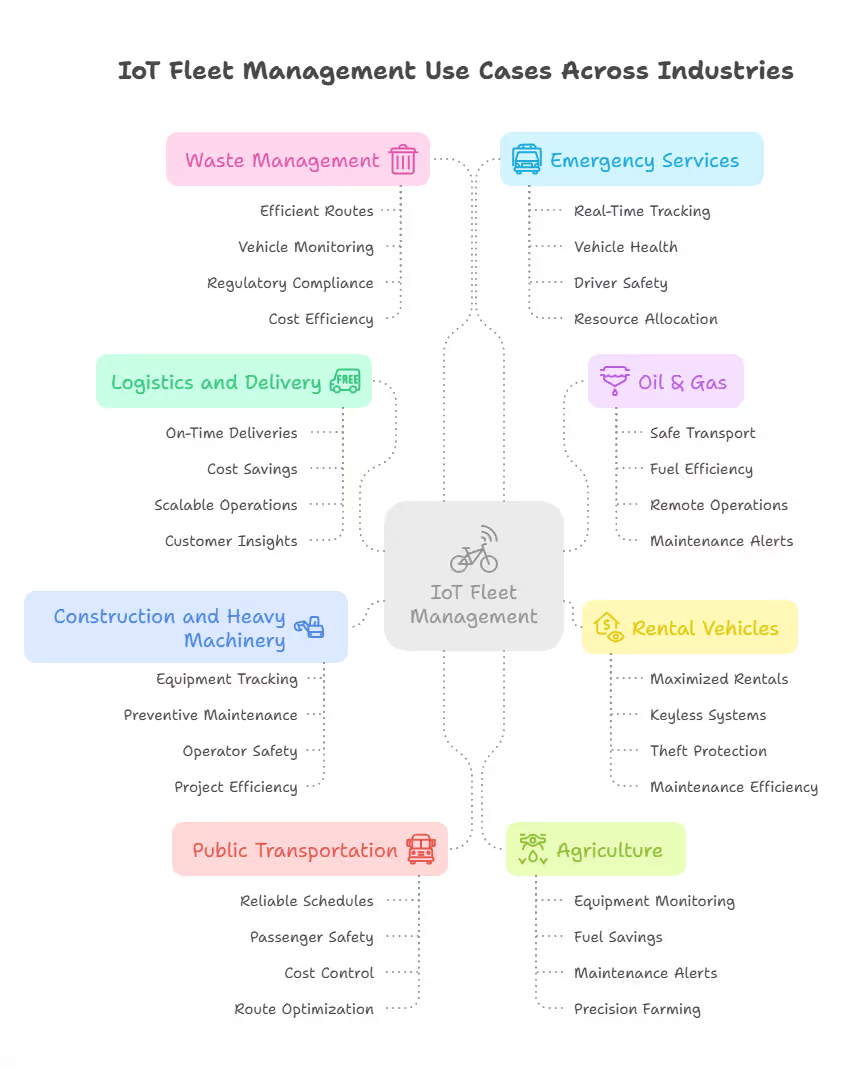IoT Fleet Management Use Cases: Driving Enterprise Efficiency

Why IoT Fleet Management Is a Must-Have for Enterprises
IoT (Internet of Things) for fleet management refers to the use of connected devices, sensors, and telematics to monitor, manage, and optimize vehicle fleets in real time. By equipping trucks, vans, and other assets with IoT-enabled devices, companies gain actionable insights into location, performance, driver behavior, fuel usage, and maintenance needs.
Key Benefits of IoT Fleet Management:
- Real-Time Vehicle Tracking – GPS and telematics provide instant updates on location, helping optimize routes and reduce delays.
- Predictive Maintenance – Sensors detect wear-and-tear on engines, tires, and parts, reducing downtime with proactive servicing.
- Fuel Efficiency – IoT solutions track fuel consumption patterns and help cut costs by identifying inefficiencies.
- Driver Safety & Behavior Monitoring – Smart sensors monitor driving patterns (speeding, harsh braking, idling), improving compliance and safety.
- Regulatory Compliance – Automated logs and reporting simplify compliance with transportation and logistics regulations.
- Cost Reduction & Productivity – Fewer breakdowns, optimized routes, and efficient resource use lead to significant cost savings.
Running a fleet is like navigating a maze of challenges, skyrocketing fuel costs, unexpected breakdowns, and delivery delays can drain profits. IoT fleet management changes the game by using smart technology to make fleets more efficient, safe, and cost-effective.
This guide is the go-to resource for CEOs, CTOs, and decision-makers in logistics, oil & gas, construction, and other high-profit industries, covering IoT fleet management use cases, how IoT revolutionizes fleet tracking, and practical steps for fleet management using IoT to transform operations with IoT fleet management solutions and IoT-based fleet management use cases.
Table of Contents
- Understanding IoT Fleet Management
- Key Benefits of IoT for Fleet Management
- IoT for Fleet Management Use Cases Across Industries
- The IoT Fleet Management Market
- Challenges in Adopting IoT for Fleet Management
- How to Implement IoT for Fleet Management
- Your Path Forward with IoT for Fleet Management
Understanding IoT Fleet Management
IoT fleet management uses connected devices to streamline fleet operations, saving time and money. It’s a critical tool for enterprises aiming to stay competitive in fast-paced industries.
How IoT Fleet Management Works
- Smart Devices and Sensors: GPS trackers, telematics units, and sensors collect data on vehicle location, speed, fuel use, and engine health, providing a complete picture of fleet performance.
- Real-Time Data Processing: Data is sent to cloud platforms for instant analysis, allowing managers to monitor fleets in real-time from anywhere.
- Advanced Analytics: Software turns raw data into actionable insights, such as optimized routes or maintenance schedules, to improve efficiency.
- System Integration: Connects with ERP, CRM, or other business tools to create a unified platform for decision-making.
Verified Market Research projects the IoT fleet management market to grow from $17.49 billion in 2024 to $119.57 billion by 2031, driven by the need for smarter operations.
Why IoT Fleet Management Solutions Are Essential
- Cost Savings: Reduces fuel, maintenance, and labor expenses, crucial for high-margin sectors like logistics and oil & gas.
- Operational Efficiency: Minimizes delays and streamlines workflows, ensuring faster deliveries and higher productivity.
- Competitive Advantage: Early adopters gain a lead in industries where efficiency is a differentiator.
- Regulatory Compliance: Simplifies adherence to strict regulations, avoiding costly fines.
IoT fleet management solutions are a strategic investment for enterprises looking to boost profits and scalability.
How IoT Revolutionizes Fleet Tracking for Enterprises
- Live Vehicle Monitoring: Tracks vehicles in real-time, ensuring accurate delivery schedules and quick responses to disruptions.
- Data-Driven Decisions: Provides insights to optimize routes, reduce idle time, and improve overall fleet performance.
- Theft Prevention and Recovery: GPS tracking deters theft and enables fast recovery of stolen vehicles.
- Enhanced Customer Trust: Shares live updates with clients, improving transparency and satisfaction.
IoT revolutionizing fleet tracking transforms fleets into responsive, efficient systems, as highlighted by Acropolium.
The Role of IoT-Based Fleet Management Use Cases
- Tailored Solutions: Customizes IoT applications to meet specific industry needs, such as safety in oil & gas or efficiency in logistics.
- Scalable Systems: Grows with your fleet, supporting operations from a few vehicles to thousands.
- Data-Driven Strategies: Uses analytics to refine daily operations and long-term planning.
- Innovation Driver: Enables new approaches, like predictive maintenance or customer analytics, to stay ahead.
Key Benefits of IoTfor Fleet Management
IoT fleet management delivers powerful advantages that directly impact your bottom line.
Here’s how it transforms operations and boosts profitability.

Real-Time Tracking with IoT Fleet Management Solutions
- Precise Location Data: GPS trackers show exact vehicle locations, reducing delays and improving delivery accuracy.
- Smart Route Optimization: Suggests the fastest paths, saving 20% on transit times, according to ToolSense.
- Centralized Fleet Oversight: Monitors all vehicles from a single dashboard, simplifying management.
- Customer Satisfaction Boost: Provides real-time delivery updates, building trust with clients.
Predictive Maintenance in IoT-Based Fleet Management Use Cases
- Vehicle Health Monitoring: Sensors track engine performance, tire pressure, and brake conditions to detect issues early.
- Proactive Repair Alerts: Predicts failures, cutting downtime by 30–40%, per Fortune Business Insights.
- Cost Reduction: Avoids expensive emergency repairs and extends vehicle lifespan.
- Real-World Impact: As an IoT developer, I’ve seen IoT-based fleet management use cases save companies millions by preventing breakdowns.
Enhancing Driver Safety with IoT Fleet Management
- Behavior Monitoring: Tracks speeding, harsh braking, and distracted driving to improve safety.
- Real-Time Alerts: Warns drivers instantly to correct unsafe habits, reducing risk.
- Accident Reduction: Cuts incidents by 30%, according to Xyte.
- Insurance Savings: Safer fleets lead to lower premiums and reduced liability costs.
Streamlined Compliance and Reporting
- Automated Driver Logs: Records hours-of-service data to meet regulatory requirements.
- Emissions Tracking: Monitors carbon output to comply with environmental standards.
- Audit-Ready Reports: Simplifies inspections, ensuring compliance and avoiding fines.
- Global Regulatory Support: Aligns with standards like ELD mandates in the U.S.
Boosting Customer Satisfaction
- Timely Deliveries: Ensures accurate ETAs with real-time tracking, delighting customers.
- Transparent Communication: Shares live delivery updates to build trust.
- Customized Services: Uses data to tailor offerings, increasing customer loyalty.
- Brand Reputation: Reliable service strengthens your company’s image.
Optimizing Fleet Utilization
- Usage Monitoring: Tracks how often vehicles are used to maximize efficiency.
- Idle Time Reduction: Cuts unnecessary downtime, saving fuel and labor costs.
- Dynamic Scheduling: Assigns vehicles based on real-time demand and availability.
- Cost Efficiency: Increases ROI by ensuring every vehicle is used effectively.
IoT for Fleet Management Use Cases Across Industries
IoT fleet management use cases show how this technology drives value across diverse sectors.
Here’s how it’s applied.

Logistics and Delivery: Maximizing Efficiency
- On-Time Deliveries: Ensures packages arrive as promised, boosting customer trust.
- Cost Savings: A 5,000-vehicle fleet I worked on cut costs by 15% using IoT fleet management solutions.
- Scalable Operations: Manages growing fleets with cloud-based platforms, ensuring flexibility.
- Customer Insights: Uses delivery data to refine services and increase satisfaction.
Oil & Gas: Safety and Cost Savings
- Safe Transport: Monitors vehicles carrying hazardous materials to ensure compliance.
- Fuel Efficiency: Webisoft reports 20% fuel savings in oil & gas fleets.
- Remote Operations: Tracks vehicles in isolated areas, critical for this sector.
- Maintenance Alerts: Prevents costly downtime in high-stakes operations.
Rental Vehicles: IoT Revolutionizing Fleet Tracking
- Maximized Rentals: Tracks usage to optimize vehicle availability and revenue.
- Keyless Systems: Simplifies customer access, speeding up rentals and improving experience.
- Theft Protection: GPS ensures quick recovery of stolen vehicles, reducing losses.
- Maintenance Efficiency: Intellisoft notes 25% higher utilization.
The IoT Fleet Management Market
The IoT fleet management market is booming, offering enterprises a chance to lead their industries.
Here’s what’s driving this growth.

Growth of the IoT Fleet Management Market
- Market Expansion: Projected to reach $20.61 billion by 2030, per Volpis.
- Key Drivers: Demand for efficiency, sustainability, and compliance fuels growth.
- Regional Trends: North America dominates, but Asia-Pacific is growing rapidly due to logistics demand.
- Investment Opportunity: Early adopters can capture market share in high-profit sectors.
Emerging Technologies Driving IoT Fleet Management
- AI-Powered Analytics: Enhances predictions for routes, maintenance, and driver behavior.
- 5G Connectivity: Speeds up data transfer for real-time insights, improving responsiveness.
- Edge Computing: Processes data locally to reduce latency and enhance decision-making.
- Blockchain Integration: Secures data for transparent reporting, as noted by FirstPageSage.
Leading Providers of IoT Fleet Management Solutions
- Verizon Connect: Offers robust tracking and safety analytics for large fleets.
- Geotab: Excels in predictive maintenance and open APIs for integration.
- Samsara: Provides scalable, end-to-end solutions for diverse fleets.
- Niche Providers: ToolSense and Xyte offer tailored solutions for smaller or specialized fleets.
Future Opportunities for IoT-Based Fleet Management
- Autonomous Vehicles: IoT will power self-driving fleets, reducing labor costs.
- Smart Cities Integration: Connects with urban systems for better traffic management.
- Sustainability Focus: Supports greener fleets with emissions tracking and reporting.
- Customer Analytics: Uses fleet data to enhance service offerings and customer retention.
Investment Potential in Fleet IoT
- High ROI: Fleet IoT delivers quick returns through cost savings and efficiency gains.
- Innovation Hub: Attracts investors in logistics, tech, and sustainability sectors.
- Scalable Solutions: Supports growth from small to enterprise-level fleets.
- Market Leadership: Positions companies as pioneers in their industries.
How to Implement IoT Fleet Management
Ready to adopt IoT fleet management? This step-by-step roadmap ensures success for enterprises.
Step 1: Assess Needs for IoT Fleet Management
- Identify Pain Points: Pinpoint issues like high fuel costs, downtime, or compliance challenges.
- Set Specific Goals: Target 20% less downtime or 15% fuel savings to measure success.
- Engage Stakeholders: Align CEOs, CTOs, and fleet managers on objectives.
- Benchmark Performance: Compare current metrics to industry standards for realistic targets.
Step 2: Select IoT Fleet Management Solutions
- Choose Hardware: Select reliable GPS trackers, sensors, and telematics units.
- Evaluate Software: Test cloud-based platforms like ToolSense or Samsara for usability.
- Compare Vendors: Assess cost, scalability, support, and integration capabilities.
- Run Pilot Programs: Deploy IoT on a small fleet to validate performance and ROI.
Step 3: Train Teams for Fleet Management Using IoT
- Driver Training: Teach eco-driving, safety practices, and how to use IoT alerts.
- Manager Training: Show how to interpret analytics dashboards for decision-making.
- Ongoing Support: Monthly sessions ensure adoption, as recommended by BiztechCS.
- Feedback Loop: Collect team input to refine processes and improve engagement.
Step 4: Monitor and Optimize IoT-Based Fleet Management
- Use Analytics Dashboards: Track KPIs like fuel use, uptime, and safety metrics.
- Generate Regular Reports: Weekly or monthly insights highlight performance trends.
- Drive Continuous Improvement: Adjust routes, maintenance, or schedules based on data.
- Share with Leadership: Regular updates maintain stakeholder support and alignment.
Step 5: Scale and Innovate with IoT Fleet Management
- Expand Deployment: Roll out IoT across the entire fleet after successful pilots.
- Adopt Emerging Tech: Integrate AI, 5G, or blockchain for enhanced insights.
- Explore New Use Cases: Apply IoT to customer analytics or sustainability initiatives.
- Stay Competitive: Monitor market trends to keep your fleet cutting-edge.
Step 6: Evaluate Long-Term ROI
- Track Cost Savings: Measure reductions in fuel, maintenance, and downtime expenses.
- Assess Customer Impact: Evaluate improvements in delivery times and satisfaction.
- Review Scalability: Ensure the system supports future fleet growth.
- Annual ROI Analysis: Reassess investments to optimize long-term benefits.
Your Path Forward with IoT Fleet Management
IoT fleet management is a transformative tool for enterprises aiming to cut costs, boost efficiency, and lead their industries. From IoT revolutionizing fleet tracking to IoT-based fleet management use cases, this technology delivers unmatched value for logistics, oil & gas, construction, and beyond.
With the IoT fleet management market set to reach $20 billion by 2030, early adoption is key to staying ahead.


